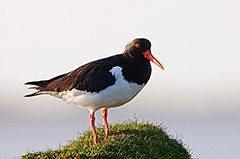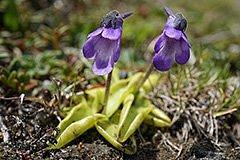
‘Bride’s Day, the birthday of spring’
_Decker_Forrest_-_for_web.jpg)
This month’s Tobar an Dualchais contribution comes from Professor Hugh Cheape who currently teaches on the MSc in Material Culture and Gàidhealtachd History at Sabhal Mòr Ostaig.
‘Bride’s Day, the birthday of spring’
With the razzamatazz and hò-ro-gheallaidh of Oidhche Challainn, Hogmanay and the New Year past, you would think we had no more celebrations to lighten the dreary days of winter beyond Celtic Connections and Burns Night. The midwinter months with their ancient threats to folk’s lives and livelihood have been called an raithe marbh na bliadhna ‘the dead quarter of the year’, and, with particular emphasis, January was am mìos marbh or ‘the dead month’.
Meeting regularly in the cèilidh-house offered a means of support; the weather and the turn of the seasons were topics of constant discussion. If the pandemic has denied us parties, here’s a well-founded excuse for one! Tobar an Dualchais holds the key to unlocking our communal memory and reminds us that on the first day of February we celebrate Latha Fhèill Brìghde or Saint Bride’s Day.
This falls in with ‘Candlemas’ on 2 February as a Christian festival and a traditional end of the Christmas season. Candlemas commemorates the presentation of the infant Jesus at the Temple in Jerusalem as described in St Luke’s Gospel and when some denominations bring candles to their church. Candlemas is also one of the so-called ‘Quarter-days’ marking the changing seasons of winter, spring, summer and autumn. It is followed by Whitsun, Lammas Day and Martinmas as the term-days with their administrative and legal implications for the payment of rents and flittings.
Saint Bride or Saint Bridget has been one of the most popular of the saints of the celtic church. Of course, there were many ‘Bridgets’, but the one whose festival date is on 1 February was ‘Bridget of Kildare’ in Leinster whose death was dated to AD 525. Bridget was one of the patron saints of Ireland and is remembered in the tradition of plaiting rush crosses around 1 February to set over doors and windows to protect the home from fire and other danger.
Saint Bride has been given unique status in Gaelic tradition as the foster-mother of Christ – Muime Chrìosda - a figure with no corroboration in the Scriptures but suggesting a warm and compassionate personality. She is said to have helped Mary at Christ’s birth in the stable and Jesus became Daltan Brìghde or the endearing ‘Bride’s little fosterling’. The status of St Bride may well be owed to her status as a goddess figure of an age before Christianity. Views of the ‘sacred’ ranged widely and the converted cannot have jettisoned this inheritance. How powerful these beliefs might have been is surely proven by us still recognising their meaning today. The fire-goddess heralded early spring – or the first hint of spring with lengthening days and a warmth in the sun. Gille-Brìghde, the ‘Servant of St Bride’ or the oyster catcher is another sign of the approach of spring with its call ‘Bi glic, bi glic’ (’Be wise, be wise’).

St Bride’s Day marks the moment when the snake or adder comes out of its hole in the ground. This was Latha Brìghde, breith an erraich ‘Bride’s Day, the birthday of spring’. Tradition bearers recorded in Tobar an Dualchais link the moment that the snake emerges from its hibernation with 1 February in sayings relating to dates and seasons of the year: ‘On St Bride’s Day, the king’s daughter will come out of the hole’ or Latha Fhèill Brìghde, thig nighean an rìgh às an toll’ (TAD ID:68255; TAD ID:78273). In the late 19th century, traditions of Saint Bride were collected by Alexander Carmichael among his prayers, hymns, blessings and charms from the Hebrides. He suggests that accounts of Saint Bride were not easily recovered and summarised the tradition:
‘The serpent is supposed to emerge from its hollow among the hills on St Bride’s Day, and a propitiatory hymn was sung to it. Only one verse of this hymn has been obtained, apparently the first. It differs in different localities:
Moch madainn Bhrìde,
Thig an nimhir às an toll,
Cha bhoin mise ris an nimhir,
Cha bhoin an nimhir rium.
[Early on Bride’s morn
The serpent shall come from the hole,
I shall not molest the serpent,
Nor will the serpent molest me.]’
The snake is a powerful element in mythology and religion and a creature to be respected as the ‘hymn’ makes clear. Familiar in the snake coiled round the rod, it is a symbol of medicine and healing, and the appearance of the adder or snake on Saint Bride’s Day offers a feeling of hope and transformation, and of turning the corner with the lengthening of the days.
In the distant past, medicine was as much faith as understanding with constant exposure to infectious disease and death. Staying safe, you might notionally put yourself under the protection of sacred figures such as Saint Bride (e.g. TAD ID:42165). Historical sources from Martin Martin onward describe how the sick and injured went for help to healers. Sparse and ineffective medical intervention and no medical care as we understand it today also ensured a strong belief in the curative and protective properties of charms and amulets. As well as bringing luck – who hasn’t got their ‘lucky stone’ or token? - the ‘charm’ was also a protective prayer or form of words. The meaning of this is reflected in the choice of title of Alexander Carmichael’s collection, Carmina Gadelica or ‘Gaelic Charms’. This was part of the fabric of everyday life and, although usages changed with the development of medical science from the 17th century, the archive of sound recordings in Tobar an Dualchais shows how important this has continued to be for us into the 20th century.
Accounts of illness or bad luck often cite the ‘evil eye’ or droch shùil as cause of animals such as horses and cattle inexplicably growing sick and the antidote being a charm and a snàidhlean or red thread put on their tails (TAD ID:74154; TAD ID:47373). More practically, a thrice-knotted thread also proved effective in curing mastitis in a cow (TAD ID:45517; TAD ID:53566)! Charming could be a comfort in the healing of human illness; a healing rhyme or duan recorded in 1960 was part of eòlas an leighis or ‘healing knowledge’, capable of treating injury such as broken bones (TAD ID:53242). The state of our teeth is a sensitive area of our physical condition and, unsurprisingly, Tobar an Dualchais is rich in charms against toothache (eòlas an dèididh). Perhaps the most interesting for the historian are the examples which invoke Christ and Saint Peter in bringing relief (TAD ID:1281; TAD ID:74153). One contributor recorded in 1965 commented that her father had a toothache charm and never suffered from toothache (TAD ID:43268). And anyone looking for relief might try a duan an dèididh or ‘toothache poem’ (TAD ID:44582).

The links with alternative medicine are close; the mòthan or butterwort has been considered a sacred plant and, as lus a’ bhainne or the milk-wort, will act as a rennet in cow’s milk to separate curds and whey. Notes made at the beginning of the 20th century by a schoolmaster in Grimsay recorded that this was a plant to protect against evil influences of all kind and sewn into clothing, to put in the bed of a woman about to bear a child, and to be taken as a restorative drink of milk from the cow who had eaten the mòthan (TAD ID: 72852).
A fascinating dimension of charms and amulets witnessed in Tobar an Dualchais is the protection offered against mortal danger, injury or death. It was a familiar practice for young men leaving home to join the army to have a charm or seun given to them. The folklorists have called this a ‘rune of protection’. There are multiple accounts of this in Tobar an Dualchais, many of them relating to the Napoleonic Wars but also to the wars of the 20th century. Typically – and thankfully - thàinig e dhachaigh thugainn slàn -‘he came home unharmed’ (TAD ID:7583; TAD ID:6748)! Another account told of the young soldier whose tunic had grown heavy in the battle and, afterwards, he shook the bullets out of it (TAD ID:47373; TAD ID:58382; TAD ID:59656; TAD ID:57493).
As older example of the seun, the fate of MacDonald of Clanranald killed in 1715 at the Battle of Sheriffmuir is frequently recounted. Listen to these recordings to hear why the charm failed (TAD ID:107380; TAD ID:45482; TAD ID:42164; TAD ID:48697). And for cautions against meeting mermaids and monsters and water-horses, search further in Tobar an Dualchais (TAD ID: 1028; TAD ID:68824)!